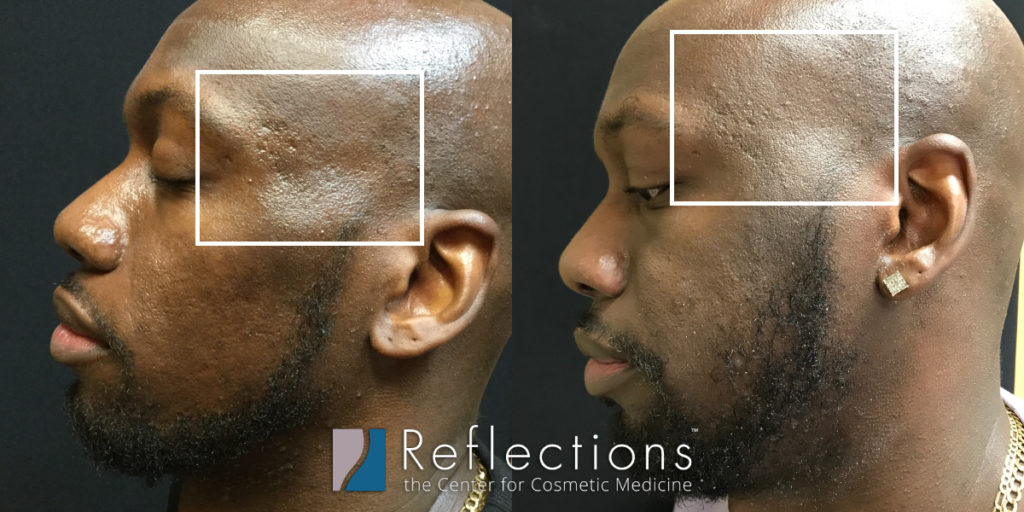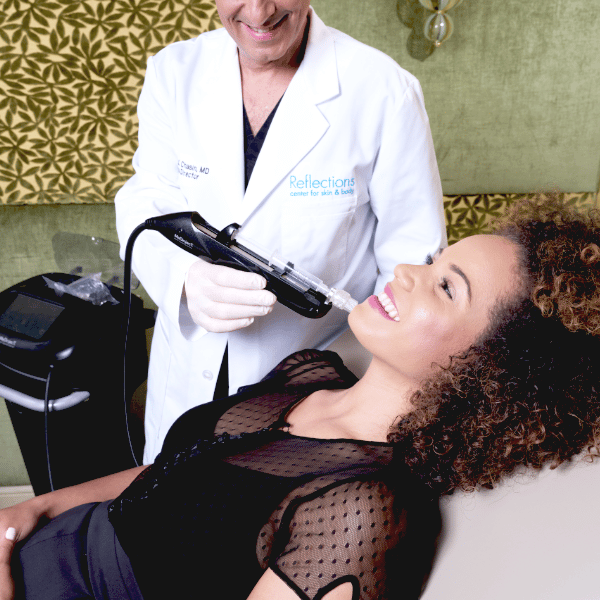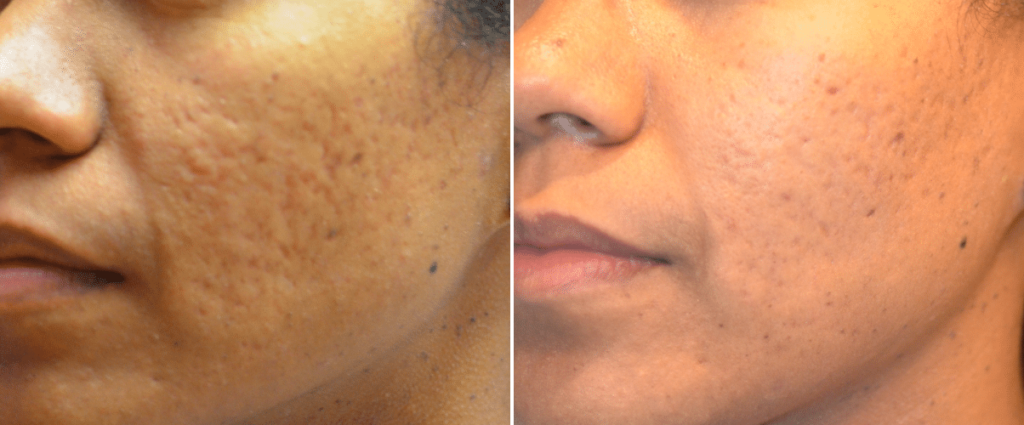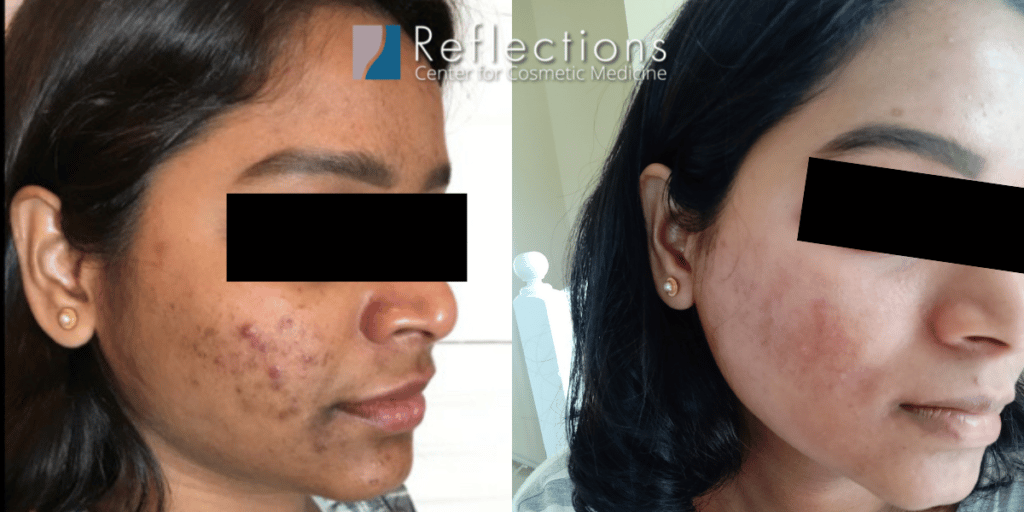Microneedling has become one of the most talked-about skincare treatments on the market. That’s because it is widely available, and has a proven history of achieving great results for skin quality, texture, fine lines, and superficial skin irregularities, like light acne scarring.
However, if you’ve been doing your research about microneedling, you may have read that it’s unsafe for darker skin tones. The truth is that this may be the case – but only for providers who aren’t knowledgeable about the inherent risks of the healing process for darker skin. This is often knowledge that’s lacking for ARNPs, PAs, nurses, and aestheticians, because unfortunately they tend not to learn that kind of fringe knowledge (not required for health of the patient) in their compressed learning timelines in school. It’s the sort of thing that really only plastic surgeons, dermatologists, wound healing clinics, and cosmetic doctors give a lot of thought to.
Is Microneedling Safe for Dark Skin?
Yes, microneedling is safe for skin of all tones and types, provided that it’s performed in specific parameters that take skin tone and healing history into consideration. This really comes down to the knowledge of the provider, more than anything else, but it’s surprisingly common to see complications because most providers are only listening to the training the manufacturer provides or that other lower-knowledge trainers are providing.

Why is Microneedling Risky for Skin of Color?
When you get a bad outcome with microneedling, it’s essentially an overreaction by the body, causing it to form scar tissue, or an excess of collagen.
We worry about the healing process for skin with more melanin because there is a correlation between “bad scarring” (raised scars, keloids, and discoloration – either complete loss of melanin, or very dark coloring) and skin with more melanin. But a correlation only means there seems to be some connection, not that it always occurs, or always occurs in a predictable way.
How Do You Know if Your Skin Has a Higher Risk for Complications with Microneedling?
- Skin with more melanin in it (i.e. you tan in the sun or already have darker skin)
- Seeing a provider who doesn’t have formal education in wound healing and/or dermatology (skin reactivity to inflammation) – this is most providers, by the way
- History of poor wound healing – i.e. keloiding, raised scars, white scars or very dark scars (if you have this history, no matter your provider or skin type, you are at a higher risk of a bad outcome with microneedling and other treatments, and you need to be very upfront about this with your provider, and careful about who you trust)
- RF Microneedling (Vivace, Morpheus, Lutronic, Endemed, etc.) adds heat to the needles, and heat that lingers in the skin, or too much heat in the skin, is a big trigger for skin of color to react negatively during the healing process. RF Microneedling can be used safely in skin of color – but only by a safe provider – especially in this case.
So the risk is higher – and because it’s not always happening, or always happening the same way, it’s very difficult for someone to know how to prevent these complications when they haven’t studied wound healing (which is essentially what happens after any treatment). And most medical provider, especially nurses, ARNPs, and PA’s, don’t learn about wound healing and how to create pretty or invisible scars during their schooling, because it’s not critical for the health of the individual, but that’s the knowledge they
When we take out the group of patients who have a history of bad reactions, the next riskiest group is patients with Skin Type 4 (olive complexion, tans easily, usually Asian, Latin American, Mediterranean heritage) who see a provider that typically treats fairer skinned patients and who lacks the knowledge of how to treat their skin differently. Unfortunately, we see a lot of these complications in our practice.

How Does a Doctor Learn to Safely Treat Skin of Color? Or a nurse, or ARNP, etc.?
Becoming an excellent (effective and safe) provider of non-surgical cosmetic treatments requires education beyond medical school, nursing school, masters degrees, etc. Formal medical education simply does not focus on this niche. And unfortunately, many providers take what knowledge they have from school and fellowships/residency, and combine it with what the manufacturer provides as training, along with the purchase of the machine.
However, the sales reps and trainers know the machine, but not necessarily every detail of how to safely treat every patient that’s going to walk in your door. And that’s where the issues arise – when providers rely on that knowledge as their foundation of safe and effective treatment.
Our doctors not only have over 60 years of combined experience in this field, which they regularly share with one another, but they also spend a significant about of time and money, reading the peer-reviewed studies, attending the best conferences, and educating themselves, to ensure they are safe and effective physicians for patients of all kinds.
Most mid-levels (ARNP or PA) and physicians can access the resources our doctors do to educate themselves, but few choose to make that investment.
How to Select a Safe Provider for Your Microneedling Treatment
How do you qualify a provider’s safety, as a potential patient?
Before & Afters for Microneedling on Skin of Color
Before & Afters that are branded to that company are always a good indication of the type of work that practice is doing a lot of. It’s important that they aren’t the photos the manufacturer provides, that were actually performed during the clinical trials or are provided as marketing support. Having videos with those patients are a great way to fact check the validity of the work they’re showing.


Are They Speaking About It?
Whether in their social media content, videos, blogs, or in the consult – you want the doctor or provider to be mentioning there is some more risk for skin of color, and asking about your history of scarring, tanning, and/or sunburning. These are all indications they are thinking about safe and effective treatment, and how skin type affects this.
You can take this a step forward and directly ask “How does my skin type impact risks for me with microneedling? What happens if things go wrong?” They should be comfortable answering these questions. The best doctors are treating complications from other clinics – so you can ask them to share some stories, or photos of revision work they’ve done, too.







